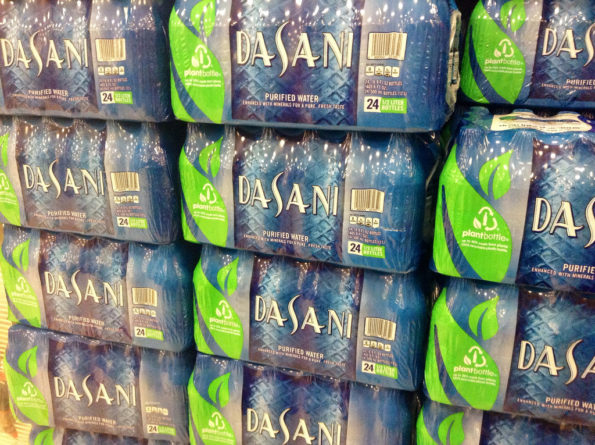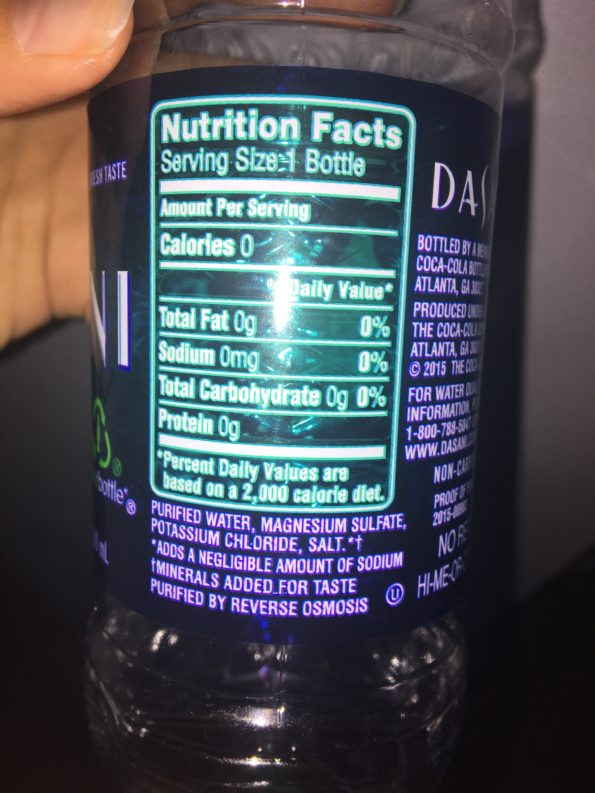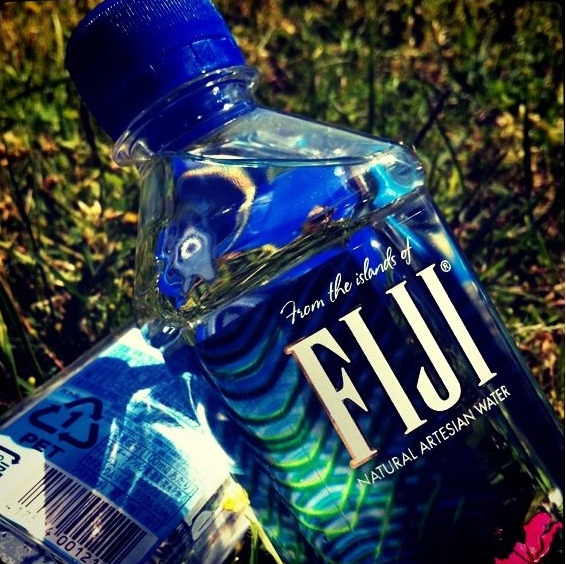[dropcap]B[/dropcap]ack in 2009, Scientific American reported the Environmental Working Group ran a series of tests on water quality and found over 300 contaminants, including harmful materials such as weed killers and the rocket fuel component perchlorate. Even more recently, in June 2017, a chemical used to make nonstick cookware was found in drinking water, as reported by Emily Weyrauch of Time Magazine. This toxic chemical has been connected to cancer, thyroid disease, and weakened immune systems, which makes you ask, what really is in the water we drink?
Look at the Ingredients
Popular water brands Dasani and Aquafina are the leading bottled water brands in the United States currently, only being second to private label brands, as shown by statistics based on sales. Why is this relevant?
Dasani Water

If you take a look at the ingredients label, you will see Dasani water contains magnesium sulfate. In an article by UCLA, is explained how it is common to find “drying agents” are commonly found in foods, pharmaceuticals, etc. Not surprisingly, magnesium sulfate is considered one, meaning instead of Dasani water products satisfying thirst like they are supposed to, instead it is almost as if the brand is intentionally trying to get customers to buy more water, as a result of still feeling thirsty.
Dasani water also contains potassium chloride, which is used in chemical abortions to stop a fetus’ heart and is the third chemical (the one that stops the heart) given to criminals receiving lethal injection according to World. Potassium chloride is found to have some questionable side effects too, such as nausea, vomiting, abdominal pain, etc. The sad part is it doesn’t even end there. It can also have some effects on the more serious side, such as bleeding, ulceration, and perforation.
[perfectpullquote align=”full” bordertop=”false” cite=”” link=”” color=”” class=”” size=””]People may be consuming dangerous drugs and potentially harmful minerals while doing something as normal as drinking a glass of water, without even realizing it, and with the government not even testing for it.[/perfectpullquote]
As if the two previously mentioned ingredients weren’t enough to make you skeptical about what really is in the water we drink, Dasani water also contains sodium, another element that will only do the opposite of what water is supposed  to do; quench your thirst. What’s even more suspicious about the fact is that the amount is unspecified, and really makes you wonder if this could be a marketing strategy to increase water sales even further. What is the point of drinking water that contains ingredients that can be potentially harmful to your body, and has elements that have the reverse effect of what drinking a liquid is supposed to do in the first place?
to do; quench your thirst. What’s even more suspicious about the fact is that the amount is unspecified, and really makes you wonder if this could be a marketing strategy to increase water sales even further. What is the point of drinking water that contains ingredients that can be potentially harmful to your body, and has elements that have the reverse effect of what drinking a liquid is supposed to do in the first place?
Where’s My Water? (Coming From)
Aquafina
Recently in 2016, True Activist explains how Pepsi owned company Aquafina, has admitted that their product is not in fact purified water or even spring water, but instead just bottled tap water. Not only was this false advertising, but this was also just another way to make an even larger profit, due to bottled water being significantly more expensive than regular tap water.
So besides just false advertising, what’s the harm in drinking Aquafina, or really just plain old tap water?
You Might Want to Check Twice Before Taking a Drink from the Sink

For starters, tap water is a lot less filtered than real bottled water. Health Wyze informs readers that it is not as uncommon as people may think to find random amounts of dissolved minerals and pharmaceuticals. Some of these include but are not limited to antibiotics, anti-convulsants, mood stabilizers, and sex hormones.
We’re drinking what?
Yep, that’s right. To make matters even worse, Thomas Corriher, author of Health Wyze’s article “The Dangers of Tap Water” explains, “The U.S. Government does not require any testing for drugs in the water supplies; nor does it set safety limits for drug contamination. It will be decades before we know the long-term effects of ingesting random cocktails of partially-digested prescription drugs.” So basically people may be consuming dangerous drugs and potentially harmful minerals while doing something as normal as drinking a glass of water, without even realizing it, and with the government not even testing for it.
What’s the Big Deal About Minerals?
One of the most commonly found minerals in tap water is fluoride. That’s a good thing because it strengthens your teeth right? Well, not exactly.
Health Wyze also informs us the fluoride that is used in tubes of toothpaste and is good for dental health is something called pharmaceutical grade fluoride, which is not the kind found in tap water. Instead, the kind found in tap water is classified by the EPA (Environmental Protection Agency) as a toxic waste product, coming from uranium processing, aluminum processing, and the making of fertilizer.
Jem Phelps, a former Oak Ridge National Laboratory researcher even reveals, “If I were to name one element or chemical compound that would represent the ‘Bane of Man’s existence on Earth’ it would be fluorine or fluoride. Fluorine has caused huge problems for man since the beginning of time due to volcanic events on Earth… and fluoride prevents the removal of toxic metals from the human body. The effect results in the rise of lead, mercury, and other toxic metals in children that impair their I.Q. and long-term health.”
Does it Really Matter?
In short, yes. According to some sources like the Natural Hydration Council, neither bottled water or tap water is safer to drink than the other, and they have to be safe to consume otherwise they would not be allowed to be distributed.
Unfortunately, that is not the case. As mentioned before, the suspicious ingredients found in popular bottled water products is unspecified and the minerals found in the less-filtered tap water have not been studied long enough to determine the long-term effects. Also even though it may be safe for us to drink, it does not mean it is the best for us.
Water You Can Trust
So if top-selling water brands like Dasani and regular tap water is potentially harmful to your health, what are we supposed to drink?
Fiji Water

Although it is known to be a little more expensive than other bottled water brands, it could be better for your health in the long run. Fiji water is a type of water called artesian water, which means it is not mineral water and is run downhill into an aquifer.
Like the name suggests, it is sourced from the island of Fiji, and is tested before and after it is transported to various parts of the world. Livestrong indicates that although there are no obvious nutritional benefits to drinking Fiji water, it does in fact contain a lower collection of minerals than mineral water itself, and is not just bottled tap water.
So Why Do Different Water Brands Taste Different?
The answer lies in the ingredients of what makes up your water of choice itself, and where the water is from.
Ever heard someone say Dasani water tastes “bad?” There’s actually a reason for that. As previously mentioned above, Dasani water contains magnesium sulfate and potassium chloride, which are known to have bitter and metallic tastes.
Aquafina water is said to taste “minerally,” probably resulting from it really being tap water, which contains lots of unspecified amounts of well, minerals.
Water brands like Fiji taste like actual water because they are natural, and don’t contain so many minerals like mineral water. Even filtered water from your fridge probably tastes better than popular mineral water brands because they are filtered.
What Can You Do?
It’s always important to know what you put into your body. A lot of these popular water brands are shown to have potentially harmful components in them, and there haven’t even been enough long-term studies to see what they could really do to your body. So maybe the next time you’re out at the store, think twice about drinking water brands like Aquafina and try to find a better alternative that could help you in the long run.
Featured image by congerdesign
